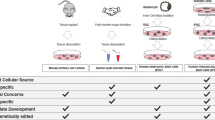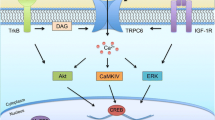Abstract
New applications of iPSC technology to research on complex idiopathic conditions raise several important ethical and social considerations for potential research participants and their families. In this short review, we examine these issues through the lens of emerging research on autism spectrum disorder (ASD). We begin by describing the current state of iPSC technology in research on ASD. Then we discuss how the social history of and current controversies in autism research combined with the emergence of autism-specific iPSC biobanks indicate an urgent need for researchers to clearly communicate the limitations and possibilities of iPSC research to ensure research participants have the ability to provide fully informed, voluntary consent. We conclude by offering recommendations to bolster informed consent for research involving iPSC biobanks, both in the specific context of ASD and more broadly.
Similar content being viewed by others
References
Takahashi, K., Tanabe, K., Ohnuki, M., Narita, M., Ichisaka, T., Tomoda, K., et al. (2007). Induction of pluripotent stem cells from adult human fibroblasts by defined factors. Cell, 131(5), 861–872.
Jang, J., Yoo, J. E., Lee, J. A., Lee, D. R., Kim, J. Y., Huh, Y. J., et al. (2012). Disease-specific induced pluripotent stem cells: a platform for human disease modeling and drug discovery. Experimental and Molecular Medicine, 44(3), 202–213.
Marchetto, M. C., Brennand, K. J., Boyer, L. F., & Gage, F. H. (2011). Induced pluripotent stem cells (iPSCs) and neurological disease modeling: progress and promises. Human Molecular Genetics, 20(2), R109–R115.
American Psychiatric Association. (2013). Diagnostic and statistical manual of mental disorders (5th ed.). Arlington: American Psychiatric Publishing.
Autism and Developmental Disabilities Monitoring Network Surveillance Year 2008 Principal Investigators. (2012). Prevalence of autism spectrum disorders—autism and developmental disabilities monitoring network, 14 sites, United States, 2008. Resource document. Centers for Disease Control and Prevention. http://www.cdc.gov/mmwr/preview/mmwrhtml/ss6103a1.htm?s_cid=ss6103a1_w. Accessed 15 July 2013.
Interagency Autism Coordinating Committee. (2012). 2010 Autism spectrum disorder research portfolio analysis report. http://iacc.hhs.gov/portfolio-analysis/2010/index.shtml. Accessed 5 June 2013.
Wu, S. M., & Hochedlinger, K. (2011). Harnessing the potential of induced pluripotent stem cells for regenerative medicine. Nature Cell Biology, 13(5), 497–505.
Dimos, J. T., Griswold-Prenner, I., Grskovic, M., Irion, S., Johnson, C., & Vaisberg, E. (2011). Induced pluripotent stem cells as human disease models. Annual Reports in Medicinal Chemistry, 46, 369–383.
Grskovic, M., Javaherian, A., Strulovici, B., & Daley, G. Q. (2011). Induced pluripotent stem cells—opportunities for disease modeling and drug discovery. Nature Reviews Drug Discovery, 10(12), 915–929.
Ebert, A. D., Yu, J., Rose, F. F., Jr., Mattis, V. B., Lorson, C. L., Thomson, J. A., et al. (2009). Induced pluripotent stem cells from a spinal muscular atrophy patient. Nature, 457(7227), 277–280.
Sinnecker, D., Dirschinger, R. J., Goedel, A., Moretti, A., Lipp, P., & Laugwitz, K. L. (2012). Induced pluripotent stem cells in cardiovascular research. Reviews of Physiology, Biochemistry and Pharmacology, 163, 1–26.
Bruck, T., & Benvenisty, N. (2011). Meta-analysis of the heterogeneity of X chromosome inactivation in human pluripotent stem cells. Stem Cell Research, 6(2), 187–193.
Gore, A., Li, Z., Fung, H. L., Young, J. E., Agarwal, S., Antosiewicz-Bourget, J., et al. (2011). Somatic coding mutations in human induced pluripotent stem cells. Nature, 471(7336), 63–67.
Hussein, S. M., Batada, N. N., Vuoristo, S., Ching, R. W., Autio, R., Närvä, E., et al. (2011). Copy number variation and selection during reprogramming to pluripotency. Nature, 471(7336), 58–62.
Lister, R., Pelizzola, M., Kida, Y. S., Hawkins, R. D., Nery, J. R., Hon, G., et al. (2011). Hotspots of aberrant epigenomic reprogramming in human induced pluripotent stem cells. Nature, 471(7336), 68–73.
Mayshar, Y., Ben-David, U., Lavon, N., Biancotti, J. C., Yakir, B., Clark, A. T., et al. (2010). Identification and classification of chromosomal aberrations in human induced pluripotent stem cells. Cell Stem Cell, 7(4), 521–531.
Pick, M., Stelzer, Y., Bar-Nur, O., Mayshar, Y., Eden, A., & Benvenisty, N. (2009). Clone- and gene-specific aberrations of parental imprinting in human induced pluripotent stem cells. Stem Cells, 27(11), 2686–2690.
National Institutes of Health. (2012). Stem cells and diseases. http://stemcells.nih.gov/info//pages/health.aspx. Accessed 14 October 2013.
Joung, J. K., & Sander, J. D. (2013). TALENs: a widely applicable technology for targeted genome editing. Nature Reviews Molecular Cell Biology, 14(1), 49–55.
DeRosa, B. A., Van Baaren, J. M., Dubey, G. K., Lee, J. M., Cuccaro, M. L., Vance, J. M., et al. (2012). Derivation of autism spectrum disorder-specific induced pluripotent stem cells from peripheral blood mononuclear cells. Neuroscience Letters, 516(1), 9–14.
Kim, K. Y., Jung, Y. W., Sullivan, G. J., Chung, L., & Park, I. H. (2012). Cellular reprogramming: a novel tool for investigating autism spectrum disorders. Trends in Molecular Medicine, 18(8), 463–471.
Marchetto, M. C., Winner, B., & Gage, F. H. (2010). Pluripotent stem cells in neurodegenerative and neurodevelopmental diseases. Human Molecular Genetics, 19(1), R71–R76.
Farra, N., Zhang, W. B., Pasceri, P., Eubanks, J. H., Salter, M. W., & Ellis, J. (2012). Rett syndrome induced pluripotent stem cell-derived neurons reveal novel neurophysiological alterations. Molecular Psychiatry, 17(12), 1261–1271.
Pasca, S. P., Portmann, T., Voineagu, I., Yazawa, M., Shcheglovitov, O., Pasca, A. M., et al. (2012). Using iPS cell-derived neurons to uncover cellular phenotypes associated with Timothy Syndrome. Nature Medicine, 17(12), 1657–1662.
National Human Genome Institute. (2012). Learning about autism. http://www.genome.gov/25522099. Accessed 14 October 2013.
Urbach, A., Bar-Nur, O., Daley, G. Q., & Benvenisty, N. (2010). Differential modeling of Fragile X syndrome by human embryonic stem cells and induced pluripotent stem cells. Cell Stem Cell, 6(5), 407–411.
Trounson, A., Shepard, K. A., & DeWitt, N. D. (2012). Human disease modeling with induced pluripotent stem cells. Current Opinion in Genetics and Development, 22(5), 509–516.
Zarzeczny, A. T., Scott, C. T., Hyun, I., Bennett, J., Chandler, J., Chargé, S., et al. (2009). iPS cells: mapping the policy issues. Cell, 139(6), 1032–1037.
NIH RePORT. Project information: 5R01HD059967-03. http://projectreporter.nih.gov/project_info_description.cfm?projectnumber=5R01HD059967-03. Accessed 29 September 2013.
U.S. Department of Health and Human Services. (2009). 45 CFR 46. http://www.hhs.gov/ohrp/humansubjects/guidance/45cfr46.html. Accessed 12 September 2013.
Wolf, S. M., Lawrenz, F. P., Nelson, C. A., Kahn, J. P., Cho, M. K., Clayton, E. W., et al. (2008). Managing incidental findings in human subjects research: analysis and recommendations. Journal of Law and Medical Ethics, 32(2), 219–248.
Knoppers, B. M., & Isasi, R. (2010). Stem cell banking: between traceability and identifiability. Genome Medicine, 2(10), 73.
Resnik, D. B. (2009). Re-consenting human subjects: ethical, legal, and practical issues. Journal of Medical Ethics, 35(11), 656–657.
Eriksson, S., & Helgesson, G. (2005). Potential harms, anonymization, and the right to withdraw consent to biobank research. European Journal of Humanities and Genetics, 13(9), 1071–1076.
Connor, S. (2013). Breakthrough with stem cells could “end need for transplants.” The Independent. http://wwww.independent.co.ulk/news/science/breakthrough-with-stem-cells-could-end-need-for-transplants-8809955.html. Accessed 28 September 2013.
Gray, R. (2013). Stem cell study raises hopes that organs could be regenerated inside patients’ own bodies. Telegraph. http://www.telegraph.co.uk/science/10302341/Stem-cell-study-raises-hopes-that-organs-could-be-regenerated-inside-patients-own-bodies.html. Accessed 29 September 2013.
Innes, E. (2013). The pea-sized brains created from SKIN that could lead to cures for disorders such as schizophrenia and autism. Mail Online. http://www.dailymail.co.uk/sciencetech/article-2404537/Tiny-brains-created-SKIN-lead-cures-disorders-like-schizophrenia-autism.html. Accessed 29 September 2013.
Kiatpongsan, S., & Sipp, D. (2009). Monitoring and regulating offshore stem cell clinics. Science, 323(5921), 1564–1565.
Murdoch, C. E., & Scott, C. T. (2010). Stem cell tourism and the power of hope. American Journal of Bioethics, 10(5), 16–23.
Jensen, C. (2013). Animal stem cells help local boy with autism. NPG of Idaho. http://www.localnews8.com/news/Animal-stem-cells-help-local-boy-with-autism/-/308662/19642398/-/bavlmy/-/index.html. Accessed 29 September 2013.
Moral, C. V. (2013). Karen Davila resorts to stem-cell therapy for son’s autism. Inquirer Lifestyle. http://lifestyle.inquirer.net/90269/karen-davila-resorts-to-stem-cell-therapy-for-sons-autism. Accessed 29 September 2013.
Singer, E. (2003). Exploring the meaning of consent: participation in research and beliefs about risks and benefits. Journal of Official Statistics, 19(3), 273–285.
Singer, E. (2004). Risk, benefit, and informed consent in survey research. Survey Research, 25(2–3), 2–24.
Bagatell, N. (2010). From cure to community: transforming notions of autism. Ethos, 38(1), 33–55.
Kapp, S. K., Gillespie-Lynch, K., Sherman, L. E., & Hutman, T. (2013). Deficit, difference, or both? Autism and neurodiversity. Developmental Psychology, 49(1), 59–71.
Orsini, M. (2009). Contesting the autistic subject: Biological citizenship and the autism/autistic movement. In S. Murray & D. Holmes (Eds.), Critical interventions in the ethics of healthcare (pp. 115–130). Abingon, Oxon, GBR: Ashgate Publishing Group.
Kreiner, T., & Irion, S. (2013). Whole-genome analysis, stem cell research, and the future of biobanks. Cell Stem Cell, 12(5), 513–516.
United Nations Educational, Scientific and Cultural Organization (UNESCO). Report of the International Bioethics Committee of UNESCO (IBC) on consent. (IBC, 2008). http://unesdoc.unesco.org/images/0017/001781/178124e.pdf. Accessed 29 September 2013.
Steinsbekk, K. S., Kare Myskja, B., & Solberg, B. (2013). Broad consent versus dynamic consent in biobank research: is passive participation an ethical problem? European Journal of Human Genetics, 21(9), 897–902.
Scott, C. T., Caulfield, T., Borgelt, E., & Illes, J. (2012). Personal medicine—the new banking crisis. Nature Biotechnology, 30(2), 141–147.
Isasi, R., Knoppers, B. M., & Lomax, G. (2011). Sustained interaction: the new normal for stem cell repositories? Regenerative Medicine, 6(6), 783–792.
Cambon-Thomsen, A., Rial-Sebbag, E., & Knoppers, B. M. (2007). Trends in ethical and legal frameworks for the use of human biobanks. European Respiratory Journal, 30(2), 373–382.
Clayton, E. W. (2005). Informed consent and biobanks. Journal of Law, Medicine, & Ethics, 33(1), 15–21.
Secko, D. M., Preto, N., Niemeyer, S., & Burgess, M. M. (2009). Informed consent in biobank research: a deliberative approach to the debate. Social Science & Medicine, 68(4), 781–789.
Acknowledgments
EYL is supported by the Stanford Center for Biomedical Ethics and NIH grant P50 HG003389 (Center for Integrating Ethics and Genetics Research). CTS is supported by the Stanford Center for Biomedical Ethics and the Stanford Institute for Stem Cell Biology and Regenerative Medicine. The authors thank Lauren C. Milner for her contribution to the conceptual phase of this work and Vittorio Sebastiano for his valuable assistance with the manuscript.
Conflict of Interest
The authors declare no potential conflicts of interest.
Author information
Authors and Affiliations
Corresponding author
Rights and permissions
About this article
Cite this article
Liu, E.Y., Scott, C.T. Great Expectations: Autism Spectrum Disorder and Induced Pluripotent Stem Cell Technologies. Stem Cell Rev and Rep 10, 145–150 (2014). https://doi.org/10.1007/s12015-014-9497-0
Published:
Issue Date:
DOI: https://doi.org/10.1007/s12015-014-9497-0




